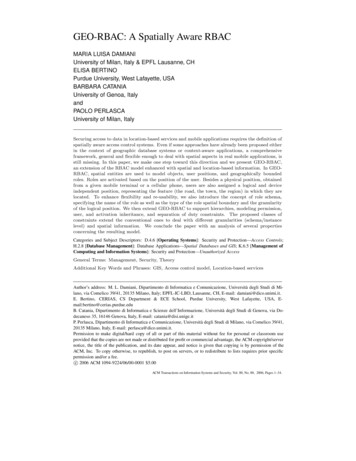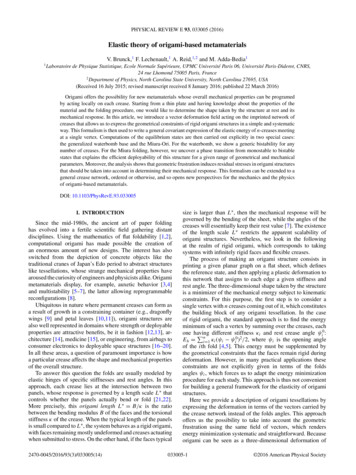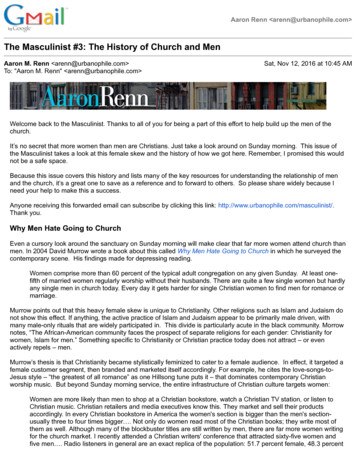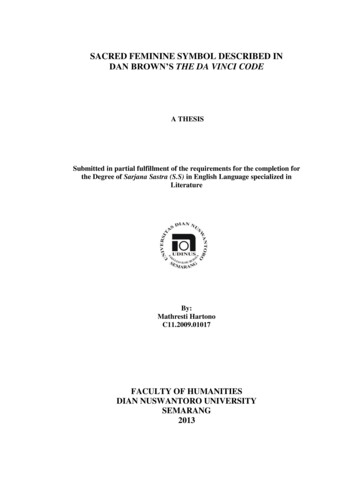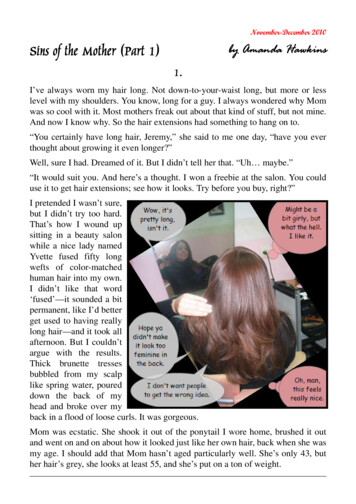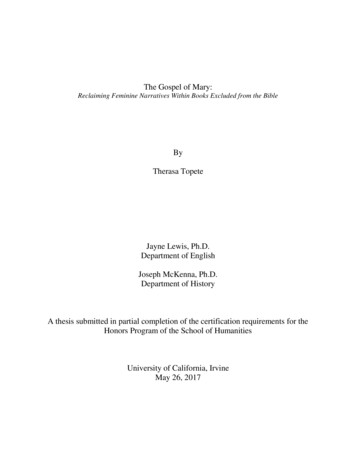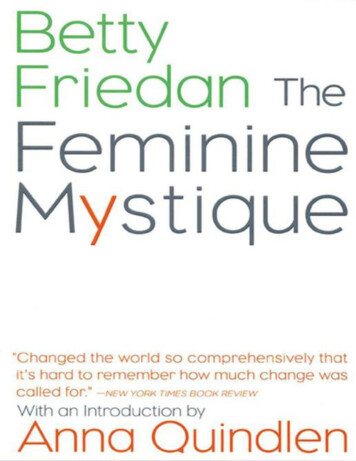
Transcription
Further praise for The FeminineMystique“Written with a passionate drive it will leave you with somehaunting facts as well as a few hair-raising stories. That TheFeminine Mystique is at the same time a scholarly work, appropriatefor serious study, only adds to its usefulness.”—Lillian Smith, Saturday Review“A highly readable, provocative book.”—Lucy Freeman, New York Times Book Review“The most important book of the twentieth century is The FeminineMystique. Betty Friedan is to women what Martin Luther King, Jr.,was to blacks.”—Barbara Seaman, author of Free and Female“The Feminine Mystique stated the trouble with women so clearlythat every woman could recognize herself in the diagnosis . Thingsare different between men and women because we now have wordsfor the trouble. Betty gave them to us.”—Caroline Bird, author of Lives of Our Own
The Feminine Mystique
Betty Friedan
The Feminine MystiqueW. W. NORTON & COMPANYNew York London
Copyright 1997, 1991, 1974, 1963 by Betty FriedanIntroduction by Anna Quindlen copyright 2001 by Anna QuindlenFirst published as a Norton paperback 2001All rights reservedFor information about permission to reproduce selections from thisbook, write toPermissions, W. W. Norton & Company, Inc., 500 Fifth Avenue,New York, NY 10110.Library of Congress Cataloging-in-Publication DataFriedan, Betty.The feminine mystique/by Betty Friedan; with a new introduction.p. cm.Includes bibliographical references.ISBN: 978-0-393-33932-11. Feminism—United States. 2. Women—United States—Socialconditions. 3.Women—Psychology. I. Title.HQ1426.F844 1997305.42’0973—DC2197–8877CIPW. W. Norton & Company, Inc.500 Fifth Avenue, New York, N.Y. 10110www.wwnorton.comW. W. Norton & Company Ltd.Castle House, 75/76 Wells Street, London W1T 3QT
For all the new women,and the new men
ContentsIntroduction by Anna QuindlenMetamorphosis: Two Generations LaterIntroduction to the Tenth AnniversaryEditionPreface and Acknowledgments1 The Problem That Has No Name2 The Happy Housewife Heroine3 The Crisis in Woman’s Identity4 The Passionate Journey5 The Sexual Solipsism of Sigmund Freud6 The Functional Freeze, the FeminineProtest, and Margaret Mead7 The Sex-Directed Educators8 The Mistaken Choice9 The Sexual Sell10 Housewifery Expands to Fill the Time
Available11 The Sex-Seekers12 Progressive Dehumanization: TheComfortable Concentration Camp13 The Forfeited Self14 A New Life Plan for WomenEpilogueNotesReading Group Guide
IntroductionAnna QuindlenMy mother is reading a paperback book at the kitchen table. This isodd. My mother is not a great reader, and usually she reads onlybefore bed, hardcover books that come from the Book-of-the-MonthClub, novels by Taylor Caldwell and Daphne du Maurier and MaryStewart. But she is hunched over this paperback, frowning, twindivots between her dark brows. I cannot remember many of thespecific details of my childhood, but I remember this moment well. Iam twelve.This is how I first encountered Betty Friedan’s The FeminineMystique. When I read the book myself, eight years later, as anassignment for a women’s studies class at Barnard, I immediatelyunderstand why my mother had become so engrossed that she foundherself reading in the place usually reserved for cooking. I don’tbelieve she was particularly enthralled by Friedan’s systematicevisceration of the theories of Sigmund Freud, or the prescientindictment of American consumerism.I think it was probably the notion of seeing her own life there inthe pages of that book, the endless, thankless cycle of dishes andvacuuming and meals and her husband’s ironing and her children’slaundry. “I begin to feel I have no personality,” one woman toldFriedan. “I’m a server of food and a putter-on of pants and a
bedmaker, somebody who can be called on when you wantsomething. But who am I?”“Who am I?” my mother must have been asking herself at the tablein the kitchen, and with her millions of others who would pore overthis painstakingly reported, fiercely opinionated book. My motherhad everything a woman after World War II was told she could want,told by the magazines and the movies and the television commercials:a husband with a good job, five healthy children, a lovely home in thesuburbs, a patio and a powder room. But in the drawer of her bureaushe kept a small portfolio of the drawings she had done in highschool, the pages growing yellower year by year. My bag lunches forschool sometimes included a hard-boiled egg, and on its shell shewould paint in watercolors, the face of a princess, a seaside scene. Icracked those eggs without thinking twice.It has been almost forty years since The Feminine Mystique wasfirst published in 1963, and since then so much has changed, and toolittle, too, so that rereading the book now feels both revolutionaryand utterly contemporary. It changed my life. I am far from alone inthis. Susan Brownmiller says the same in the opening pages of hermemoir of the women’s movement. It changed Friedan’s life, too. Shebecame a celebrity, a pariah, a standard bearer, a target. She foundedthe National Organization for Women and her name becamesynonymous with the Equal Rights Amendment and late-twentiethcentury feminism.And it changed the lives of millions upon millions of other womenwho jettisoned empty hours of endless housework and found work,and meaning, outside of raising their children and feeding theirhusbands. Out of Friedan’s argument that women had been coaxedinto selling out their intellect and their ambitions for the paltry priceof a new washing machine—“A baked potato is not as big as theworld,” she noted puckishly of their stunted aspirations—came agreat wave of change in which women demanded equality and parityunder the law and in the workplace. Hillary Rodham Clinton, RuthBader Ginsburg, girls in Little League, women rabbis: it is noexaggeration to say that The Feminine Mystique set the stage forthem all.What Friedan gave to the world was “the problem that has noname.” She not only named it but dissected it. The advances ofscience, the development of labor-saving appliances, thedevelopment of the suburbs: all had come together to offer women in
the 1950s a life their mothers had scarcely dreamed of, free fromrampant disease, onerous drudgery, noxious city streets. But the greenlawns and big corner lots were isolating, the housework seemed toexpand to fill the time available, and polio and smallpox werereplaced by depression and alcoholism. All that was covered up in akitchen conspiracy of denial. “If a woman had a problem in the1950’s and 1960’s, she knew that something must be wrong with hermarriage, or with herself,” Friedan wrote, based on both herreporting and her own experience.This was preposterous, she argued. Instead the problem was withthe mystique of waxed floors and perfectly applied lipstick. Shereinforced her sense of what was wrong with studies showingdiminished ambitions for students at women’s colleges like Vassarand Smith, increasing psychological treatment for young mothers inthe suburbs, lower ages of marriage and childbirth as the mystiquebecame the only goal in the lives of women. Those who think of thebook as solely a feminist manifesto ought to revisit its pages to get asense of the magnitude of the research and reporting Friedanundertook.It is an ambitious book in that way, a book wary of those manywho will want to attack both the messenger and the message, a bookcarefully marshaling and buttressing its arguments. And it is anambitious book in its scope, too. It might have been an important onesimply on the basis of its early chapters detailing the vague malaiseafflicting women who were thought to be a uniquely blessed andcontented generation. But it is an enduring one because of the otherrelated issues Friedan addresses. Her explication of the role ofconsumerism to reinforce American social strata is stunning, evennow that we take the buying and the selling of ourselves for granted.In every great manifesto there are riveting moments of selfawareness. In The Feminine Mystique one of them is the rhetoricalquestion “Why is it never said that the really crucial function, thereally important role that women serve as housewives is to buy morethings for the house.”At moments like those the reader must remind herself that thisbook was written well before the consumer movement, the anti-warmovement, the movement toward a counterculture. It was prescient,and it continues to be so. For while the lives of women have changedradically in many ways since Friedan described a generation ofeducated housewives maniacally arranging the silverware and
dressing to welcome their husbands home from work, the covertmessages the culture sends to women today are still pernicious. Sothe chapters that describe the overinvestment of mothers in theirchildren, “the cult of the child,” still resonate both with women whohave chosen not to work outside the home and those who have, bothof whom feel under cultural fire. And the description of children whonever grow up might as well have been written yesterday. “Behindthe senseless vandalism, the riots in Florida at spring vacation, thepromiscuity, the rise in teenage venereal disease and illegitimatepregnancies, the alarming dropouts from high school and college,was this new passivity. For those bored, lazy, ‘gimme’ kids, ‘kickswas the only way to kill the monotony of vacant time.’” Forty yearsago those words appeared. It seems scarcely possible.In those forty years The Feminine Mystique has sometimes beendevalued. Friedan the author became inextricably intertwined withFriedan the public figure, the latter often identified with internecinesquabbles with other feminist leaders and a combative publicpersona. In hindsight the shortcomings of the book become clear. Toomuch attention is paid to the role of institutions and publications inthe reinforcement of female passivity, too little to the role ofindividual men who have enjoyed the services of a servant class andstill resent its loss. Friedan’s own revisiting of the material in TheSecond Stage (1981) was not as rigorous or well-researched as TheFeminine Mystique had been. While she attempted to make validpoints about why some women have chosen to embrace childrearingand a domestic life, the revisionist message of this second bookappeared to be an apologia for the ferocity of her first.Perhaps there also has come to be a certain feeling among thesmug overachievers of the post-Mystique generation that time hadpassed, and passed the book by, that we had moved away from theprimer into the advanced course in seizing control of our own lives. Iplead guilty on this count. I expected to revisit this book as I would aperiod piece, interesting, worthy of notice and of homage, yet a littledated and obvious as well. The daughter of a quiet and containedhousewife, I had become an opinion columnist in the onslaught ofchange that this book began, and I expected to be properly grateful.Which is to say, slightly condescending.As casually as I once cracked those painstakingly painted eggs asa girl, I cracked the spine of this book. And, as my mother had been,in a different world, at a different time, under hugely different
circumstances, I was enrapt. Four decades later, millions ofindividual transformations later, there is still so much to learn fromthis book about how sex and home and work and norms are used totwist the lives of women into weird and unnatural shapes. It set off asocial and political explosion, yet it also speaks to the incompleterebuilding of the leveled landscape. “Giving a name to the problemthat had no name was the necessary first step,” Friedan concludes inthe epilogue. “But it wasn’t enough.” Much, much more wasnecessary to change our lives. But as a first step, this one isextraordinary. As a writer, I say, “Brava!” As a beneficiary of thegreatest social revolution in twentieth-century America, theresurgence of feminism that began with The Feminine Mystique, I amobliged to add, “Many, many thanks.”
MetamorphosisTwo Generations LaterAs we approach a new century—and a new millennium—it’s themen who have to break through to a new way of thinking aboutthemselves and society. Too bad the women can’t do it for them, orgo much further without them. Because it’s awesome to consider howwomen have changed the very possibilities of our lives and arechanging the values of every part of our society since we brokethrough the feminine mystique only two generations ago. But it can’tgo on in terms of women alone. There’s a new urgency coming fromthe changing situation of men, threatening to women unless men breakthrough. Will women be forced to retreat from their empoweredpersonhood, or will they join with men again in some new vision ofhuman possibility, changing the man’s world which they fought sohard to enter?Consider the terms of women’s new empowerment, the startlingchanges since that time I wrote about, only three decades ago, whenwomen were defined only in sexual relation to men—man’s wife, sexobject, mother, housewife—and never as persons definingthemselves by their own actions in society. That image, which Icalled “the feminine mystique,” was so pervasive, coming at us fromthe women’s magazines, the movies, the television commercials, allthe mass media and the textbooks of psychology and sociology, that
each woman thought she was alone, it was her personal guilt, if shedidn’t have an orgasm waxing the family-room floor. No matter howmuch she had wanted that husband, those children, that split-levelsuburban house and all the appliances thereof, which were supposedto be the limits of women’s dreams in those years after World War II,she sometimes felt a longing for something more.I called it “the problem that had no name” because women wereblamed then for a lot of problems—not getting the kitchen sink whiteenough, not pressing the husband’s shirt smooth enough, thechildren’s bedwetting, the husband’s ulcers, their own lack oforgasm. But there was no name for a problem that had nothing to dowith husband, children, home, sex—the problem I heard from somany women after I served my own time as a suburban housewife,fired from a newspaper job for being pregnant, guilty anyway aswomen were made to feel then for working outside the home, thatthey were undermining their husband’s masculinity and their ownfemininity and neglecting their children. I was not quite able tosuppress the writing itch, so, like secret drinking in the morningbecause no other mommy in my suburban world “worked,” Ifreelanced for women’s magazines, writing articles about women andtheir children, breast feeding, natural childbirth, their homes andfashions. If I tried to write about a woman artist, a political concern,“American women won’t identify,” the editors would say. Thoseeditors of women’s magazines were men.All the terms in every field and profession then were defined bymen, who were virtually the only full professors, the law partners,the CEOs and company executives, the medical experts, theacademicians, the hospital heads and clinic directors. There was no“woman’s vote” women voted as their husbands did. No pollster orpolitical candidate talked about “women’s issues” women were nottaken that seriously, women didn’t take themselves that seriously.Abortion was not a word printed in newspapers; it was a sleazycrime that shamed and terrified and often killed women, and whosepractitioners could go to jail. It was only after we broke through thefeminine mystique and said women are people, no more no less, andtherefore demanded our human right to participate in the mainstreamof society, to equal opportunity to earn and be trained and have ourown voice in the big decisions of our destiny, that the problems ofwomen themselves became visible, and women began to take theirown experience seriously.
Consider, in the summer of 1996, that the women athletes takingthe Olympic medals—from tennis, track and field, to soccer,basketball, kayak, mountainbike—in every possible competition,were virtually the main show, the target of prime-time television. Inmy growing up, or my daughter’s, there were no women playing inmajor sports—no serious athletic training for girls in schools, onlyboys—until the women’s movement demanded and won an end to sexdiscrimination in education, including athletic training, in Title 9 ofthe Civil Rights Act as Title 7 banned discrimination in employment—equal opportunity to work, and play, to the limit of one’s ability,for women and men.Consider in 1996 that the issue of abortion as women’s choicewas the crucial issue splitting the Republican party. Long since thewomen’s movement declared the basic right of a woman to choosewhether or when to have a child, long since the Supreme Courtdeclared that right as inalienable as any right specified in theConstitution and Bill of Rights, as they were originally written of byand for the people that were men, long since the Democratic partycommitted itself to the right to choose, and long since thefundamentalist Religious Right has been fighting a vicious rearguardaction, harassing and bombing abortion clinics. The Republican partywon elections in the past inflaming fears and hate over the issue ofabortion. In 1996 their platform’s demand for a constitutionalamendment criminalizing abortion again, putting the fetus over the lifeof the woman, alienated many Republican women and men, a lastdesperate attempt to turn the clock back. As it became clear thatwomen, now registered to vote in increasing majority over men,would elect the next president of the United States, not just choice butissues like family leave, the right to women not to be forced out ofhospitals less than 48 hours after giving birth, the right of parents totake time off to take children to the dentist, or for a parent-teacherappointment became serious political business.While some media, ads, and movies may still try to define womenonly or mainly as sex objects, it’s no longer considered chic or evenacceptable by much of America. Far from being unspeakable andinvisible, sexual abuse of women and less overt forms of sexualharassment are now considered serious enough crimes to bring downa senator or Supreme Court justice or even a president. In fact, themedia’s, political muckrakers’, and even feminists’ obsession withsuch charges, which originated as an expression of women’s new
empowerment, now begins to seem almost diversionary. In the focuson sexual harassment, sexual politics has become obsessed with whatmay in fact be a dangerous symptom of increasing male rage andfrustration over economic anxieties, job downsizing, stagnant wages,and career impasse or decline. Sexual politics, we remind ourselves,started out as a reaction against the feminine mystique. It was anexplosion of women’s pent-up anger and rage against the put-downsthey had to accept when they were completely dependent on men, therage they took out on their own bodies and covertly on husbands andkids. That rage fueled the first battles of the women’s movement, andsubsided with each advance woman made toward her ownempowerment, her full personhood, freedom.But sexual politics now feeds the politics of hate and the growingpolarization of America. It also masks the real threats now towomen’s empowerment and men’s—the culture of corporate greed,the downsizing of jobs hitting even college-educated white males,with nearly a 20 percent loss of income in the last five years, to saynothing of minority, blue-collar, and those with less education. 1 Abacklash from the men, egged on by media and political hatemongers,can make scapegoats of women again. But women are no longer thepassive victims they once felt themselves to be. They cannot bepushed back easily into the feminine mystique, though some veryshrewd women like Martha Stewart are making mega-millions onelaborate do-it-yourself decor and cuisine, selling pretend femininemystique pursuits as chic new choices.The fact is women are now carrying some 50 percent of theincome-earning burden in some 50 percent of households.2 Womenare now nearly 50 percent of the labor force.3 Fifty-nine percent ofwomen work at jobs outside the home, including the mothers of youngchildren.4 And women’s wages are now about 72 percent of men’s. 5They are not equal at the top; most of the CEOs, law partners,hospital heads, full professors, cabinet members, judges, and policechiefs are still men. But women are now represented in all levelsbelow the very top. And more Americans now work for companiesowned or run by women than by the Fortune 500.But it’s troubling to learn that the closing of the earnings gendergap has come only one-third (34 percent) from increases in women’searnings; most of it (66 percent) is accounted for by a drop in men’searnings.6 And while more and more women have entered the labor
force in these years, more and more men have dropped out or beenforced out.It is men, first minority men, now white men, first blue-collar,now middle management, who have been the main victims ofcorporate downsizing. Because it’s the blue-collar and middlemanagement jobs held mainly by men that have been eliminated, notjust by technology but in the short-term interests of increasing thestock-market price by getting rid of men’s higher wages and benefits.Women’s service jobs, in areas such as the health professions, arethe part of the economy that is growing, but those jobs areincreasingly being “contracted out,” put on a temporary or contingentbasis without benefits.Many women’s jobs, especially those contingency jobs, are notbrilliant careers, but poll after poll shows women today feelingpretty good about their complex lives of job, profession, and theirvarious choices of marriage and motherhood. Women feel that zeststill, with so many more choices than their mothers had, since theybroke out of the feminine mystique. But the sexual politics that helpedus break through the feminine mystique is not relevant or adequate, iseven diversionary, in confronting the serious and growing economicimbalance, the mounting income inequality of wealth, now threateningboth women and men.Men, whose very masculine identity has been defined in terms oftheir score in the rat race, knocking the other guy down, can no longercount on that lifetime climb in job or profession. If they themselvesare not yet downsized out, brothers, cousins, friends, co-workershave been. And they are more dependent now on wives’ earnings.The real and growing discrepancy affecting both women and men isthe sharply increased income inequality between the very rich—thetop 10 percent, who now control two-thirds of America’s wealth—and the rest of us, women and men. In the last decade, 80 percent ofAmericans have seen their incomes stagnate or decline.7 The onlyreason more families are not pushed into poverty is that both womenand men are working. But in the present culture of greed, where all ofus are told we can get rich in the stock market, it’s easier to deflectthe anxiety and insecurity that is growing among Americans, womenand men, according to the polls—despite the booming stock marketand corporate profits and the Dow Jones Index going through the roof—into sexual politics, and racial and intergenerational warfare.Easier to deflect the rage by turning women and men, black and
white, young and old, against each other than to openly confront theexcessive power of corporate greed.I would like to see women and men mounting a new nationwidecampaign for a shorter work week, as over half a century ago, laborfought for the 40-hour week, now perhaps a 30-hour week, meetingthe needs of women and men in the childrearing years who shouldn’tbe working 80-hour weeks as some do now. A six-hour day, parentsat work while kids are at school, also fitting the needs of men andwomen who from youth on will have to combine work with educationand further training, and people over sixty who we know now neednew ways to continue contributing their experience to society ratherthan draining it as candidates for nursing homes. More jobs foreverybody, and new definitions of success for women and men.The old wars still divide us. In the Mitsubishi plant in Normal,Illinois, ten miles from Peoria where I grew up, a group of womenhave filed the largest lawsuit in sexual harassment history, againstmen alleged to have subjected them to mauling of buttocks andbreasts and obscene name-calling, “slut” and “whore,” as well asrefusing to give them the training and support they needed in theirnontraditional jobs. In that part of Illinois, with the Caterpillar strikelost, those Mitsubishi jobs were the only good jobs left. The menwere clearly threatened as women began to take those jobs. I wasproud of NOW, the National Organization for Women (which Ihelped start when I saw we needed a movement to get beyond thefeminine mystique and participate as equals in the mainstream ofsociety), when it went to Japan to be joined by forty-five Japanesewomen’s organizations to take on Mitsubishi in its own base. Butwomen’s victory over male abuse can’t last, isn’t solid, until thecauses of that insecurity and rage are addressed by and for womenand men.Still, the new power of women is being felt all over the worldnow as was made clear in 1995 at the Beijing conference. When theauthoritarian Chinese government could not get the Olympics, itwelcomed the UN World’s Women’s Conference, expecting thewomen to shop and pose in pretty pictures against picturesqueChinese backdrops. When 40,000 women from women’sorganizations, in movement all over the world, demanded visas, andprotested at Chinese embassies when they were denied, the Chinesegovernment tried to wall off the nongovernment conference into an
isolated suburb. But they could not stop the women of the world.Told they could demonstrate only at a children’s playground, womenfrom Tibet who had been denied visas brought CNN to thatplayground and, shrouded in black, took their story to the wholeworld. Hillary Rodham Clinton asserted “women’s rights are humanrights” to the whole world. The official delegates to that UNconference were, of course, women now, empowered women, wheretwenty years ago they were men or wives and secretaries of maleofficials who took their government’s seats at the crucial votes. Thewomen this time not only declared a woman’s right to control herown sexuality and her childbearing as a universal human right, butdeclared the genital mutilation of little girls a crime against humanity.Under the feminine mystique, men all over the world took for grantedtheir right to beat or abuse their wives. Now, in the United Statesand, after Beijing, in the world, they no longer can assume that right.In the United States, the Department of Justice has set up an office totrain police to deal with violence against women.Violence against women seems to be increasing in the UnitedStates, partly because women are reporting as abuse what they usedto accept passively as private shame, but maybe also because men’sincreasing frustration and desperation is being taken out on women.Studies and reports from California, Connecticut, and elsewhereshow an increase in sexual abuse and violence against women, aswell as suicide, child abuse, and divorce, in the face of corporatedownsizing, and the lack of community, the dwindling of time andconcern for larger purposes in the “me” decade. But women’sconcerns now go beyond their own security. It was concern for theirfamilies, and not only their own families but those poorer orotherwise less fortunate, that motivated American women in 1996 torise up against the Republican’s threats to cut Medicare, Medicaid,welfare, Social Security, student loans, child immunizations, and theprotection of the environment. Co-opting feminist rhetoric did not getwomen’s votes for politicians who threatened the welfare ofchildren, old people, the sick, and the poor. Abstractions of “balancethe budget” did not mask for women the danger of gutting governmentprograms that protect children and older people, the sick and thepoor, to provide tax cuts for the rich. A decade after the women’smovement, a study by the Eagleton Institute at Rutgers Universityshowed that the addition of even two women to a state legislaturechanges the political agenda, not just in the direction of women’s
rights, but to basic concerns of life—the lives of children, olderpeople, the poor, and the sick.And so, paradox or full circle, or transcendent thesis, in thesethirty-odd years, women breaking through the feminine mystique totheir own political and economic participation and empowerment inthe mainstream of society are not becoming more like men but areexpressing in the public sphere some of the values that used to beexpressed or allowed only in the private nurture of the home. Themystique we had to rebel against when it was used to confine us tothe home, to keep us from developing and using our full personhoodin society, distorted those real values women are now embracing,with new power and zest, both in the privacy of the home and in thelarger society. And in so doing, they are changing the political andpersonal dimensions of marriage and families, home and the societythey share with men.Marriage, which used to be a woman’s only way to socialfunction and economic support, is now a choice for most women aswell as for men. It no longer defines a woman completely as it neverdid a man; she often keeps her own name now or husband and wifetake each other’s hyphenated. In breaking through the femininemystique, some early feminist radical rhetoric seemed to declare waron marriage, motherhood, family. The divorce rate of those 1950sfeminine mystique marriages exploded from the 1960s to the 1980s.Before, no matter who went to court, it was only the man who had theeconomic and social independence to get a divorce. Since then,women in great numbers can and do get
primer into the advanced course in seizing control of our own lives. I plead guilty on this count. I expected to revisit this book as I would a period piece, interesting, worthy of notice and of homage, yet a little dated and obvious as well. The daughter of a quiet and contained housewi


